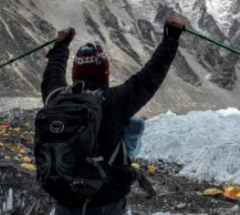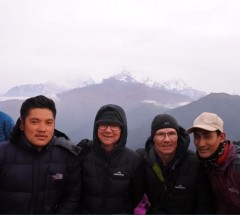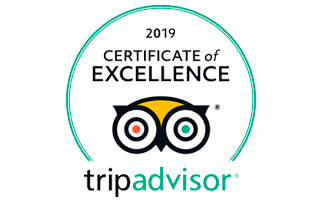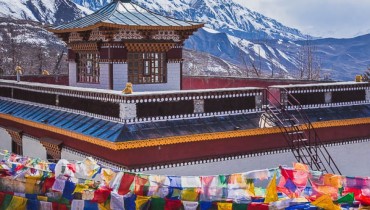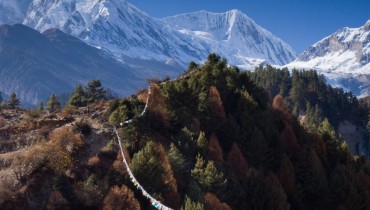Day 01: Arrival day in Kathmandu (1,300m/4,264 ft)
Upon your arrival at the Tribhuwan International Airport (TIA) in Kathmandu, you will be greeted by a company representative, who will drop you off at our hotel. After checking in, take a rest or visit Amazing Nepal's office. You may also stroll in the streets of Thamel, a tourist hub in Kathmandu for some souvenir shopping. In the evening, there will be a welcome dinner hosted by Amazing Nepal Trek & Expedition. For dinner, you will be served excellent Nepalese cuisine which will introduce you to the country's authentic food culture. If your flight arrives late, both the meeting and dinner can be scheduled for the following day. Overnight in Kathmandu.
Day 02: Sightseeing Kathmandu Valley and Preparation for Trekking (1,300m/4,264ft)
After breakfast, you will set out for sightseeing of the culturally and architecturally rich heritage sites of the Valley. Places such as the Pashupatinath, the world famous temple precinct of the Hindus, the Boudhnath and Swaymbhunath, the world famous Buddhist stupa precinct, and Kathmandu Durbar Square will open up completely a new cultural world of Nepali art and architecture to you. You will also be taken to the Kumari Ghar, where resides the Virgin Goddess. We will also discuss the trip, and you will be introduced to your fellow trekkers and our crews.
Day 03: Drive to Beshishahar (830m/2,723ft), 6-7 hrs
This morning we leave Kathmandu for our long trek to Annapurna. Drive by local bus to Beshishahar through the beautiful Nepalese countryside. Beshishahar is big town and district headquarters of the Lamjung District, explore the surrounding area and overnight at the hotel.
Day 04: Trek to Bahundanda (1,310m/4,298ft), 5-6 hrs
Today, we begin our trek from Beshishahar with a fine view of Hiunchuli and peak 29 (Ngadi Chuli) and crossing some local wooden & bamboo bridges reaches Bhulbhule. It then continues to Ngadi village for lunch passing through the river bank before reaching Bahundanda for overnight. This is the beautiful village on a top of the hill and you may have a chance to explore the evening time to the local village and around the school areas.
Day 05: Trek to Chamje (1,410m/4,626ft), 5-6 hrs
After breakfast, the trek descends to Syange village crossing fields and local villages, a short downhill walk brings you Syange village is reached after crossing a long suspension bridge, and our trek continues gradually uphill from the river and the last steep climb to get to Jagat for lunch stop. From here an hour further walk on the rocky path & long scenic waterfall across the river and finally brings you at Chamje for the overnight stop.
Day 06: Trek to Dharapani (1,960m/6,430ft), 5-6 hrs
From Chamje a short walk brings to a suspension bridge over the raging Marshyangdi river, after crossing the bridge it's another steep climb for another 2-3 hours till Tal, the village is situated on the gorge-valley by the side of the river Marshyangdi and decorated with beautiful waterfall & sandy spread river. The further trek follows the upstream up to the Dharapani, which is through the rocky trails and crossing few suspension bridges and small teashops bring you at quite a large village at Dharapani for the overnight at hotel.
Day 07: Trek to Chame (2,710m/8,891ft), 6-7 hrs
We continue our trek further to Chame. From where the vegetation changes, people and the landscapes changes and the air will get cooler, the trail then climbs through pine forests to Bagarchhap, the first village on the trek with typical Tibetan architecture. After a pleasant walk to Bagarchhap, the altitude slowly gains as we come at Danaque and to the alpine region passing through farm, orchards and beautiful pine forest with views of towering peaks of Manaslu, Lamjung and Annapurna II, the trail follows the river Marshyangdi upstream passing by the villages of Timang, Thangchok, and Koto before further half an hour brings you at Chame for overnight at the hotel. This is the headquarter of Manang district with a grand view of Annapurna II.
Day 08: Trek to Pisang (3,200m/10,496ft), 5-6 hrs
The trails lead from the other side of the river on the northern bank passes through pine woods and small villages with few ups and downs till you reach the orchard village of Bhartang for an apple orchard. We continue on the gradual path up to a bridge, from the bridge a short steep climb through the pine forest brings you at the top of the ridge of Dhukur Pokhari for the lunch. After walking out of the tree line a great view of Pisang peak on the north and the Chulu peak can be seen with Pisang village below you, from this top a gentle descent of one hour brings you to the windswept village of Pisang for overnight. Evening visit upper Pisang for the Tibetan style of houses and monastery with a panoramic view of the Annapurna range and valley.
Day 09: Trek to Manang (3,500m/11,482ft), 4-5 hrs
The trek starts with a pleasant walk through pine forest and the scenic view. The walk climbs gently up for half an hour and reaching the top, stop at a ridge to get our first view of the Manang valley, This grand spot offers a spectacular views of the valleys, Humde village with its short air-strip and the great peaks of Gangapurna, Annapurna II & III, Tilicho and on the right Chulu east, on the back Pisang peak. The walk forward to Humde and pleasant walk up to the Braga village for traditionally built up Tibetans style of houses and if can be visited the monastery, it has an outstanding display of statues, Thanka paintings, and the religious manuscripts. From here it is only an hour walk to Manang for the overnight.
Day 10: Acclimatization day at Manang (3,500m/11,482ft)
Today is full of rest for acclimatizing and explore Manang. The village of about 500 flat-roofed houses is the picturesque set amongst some spectacular scenery -Annapurna II, Annapurna III (7,555 meters), Gangapurna (7,454 meters) to the South - Tilicho (7,132 meters) and the Grand Barrier to the West - Chulu West (6,583 meters) and Chulu East (6,059 meters) to the North. After exploring and relaxing day at Manang, visit the Himalayan Rescue Association aid post if needed or go for a movie show.
Day 11: Trek to Yak Kharka (4,110m/13,484ft), 3-4 hrs
After a wonderful time at Manang, the trail leads to a slow climb up for an hour to the Tenki Manang for enclosing view of the Annapurna, Gangapurna and Tilicho peak. The track gently winds up offering inspiring views and through terrains with juniper bushes as the only surviving vegetation around this region and will brings you at Yak-Kharka for the overnight.
Day 12: Trek to Throng Phedi (4,400m/14,432), 3-4 hrs
We start our trek with slow and own pace to get to Phedi. We still have the same amazing view of mountains and landscapes. After an hour walk reaches Ledar and continues to climb along the east bank of the Jorsang Khola, then descends and crosses the stream on a wooden bridge to get a small tea shop. We stop for a wonderful view and tea breaks, we follow a narrow path across a high, unstable slope before heading to Thorong Phedi for the overnight. Phedi, which means 'foot of the hill', is a common Nepali name for any settlement at the bottom of a long climb.
Day 13: Trek to to Muktinath (3,800/12,467ft) via Throng-La (5,416m/17,765 ft), 7-8 hrs
Today is the longest and hardest day of the whole trip. We start our walk early in the morning with packed lunch and the trail becomes steepest initially and reaches high camp. Walk at your own pace viewing with sunrise and glimpse of the mountains. We continuing walk to the top takes 3-4 hrs to the Throng-La top and with a great feeling of victory take a short break for picturesque scenery and down to the Mustang part of mountains and the Kaligandaki valley far below to the West. Finally, we made to Muktinath, one of the famous pilgrimage site in Nepal, after 7-8 hrs long walk and overnight at lodge.
Day 14: Trek to Marpha (2,670m/8,760ft), 6-7 hrs
We visit temple in the morning and continuing our journey descending to the Kaligandaki river valley floor, with a brief stop at Ekle Bhatti meaning a lonely teahouse, from here onwards the valley gets very windy path, the walk follows the gentle trail for another two hours till the large town of Jomsom a town and a headquarter of the Mustang region with a small airstrip just above the Kaligandaki River. After lunch at Jomsom further, two hours of easy walk towards south-east brings us at Marpha for the overnight stop, which is a little gem, with whitewashed houses, paved streets and numerous well kept lodges. Here you will have time to celebrate with the local apple products like cider, brandy and juice and dinner with apple pie.
Day 15: Trek to Ghasa (2,120m/6,955ft), 6-7 hrs
Today, the walk is very enjoyable following the Kaligandaki river downstream reaches another charming village at Tukuche, close beneath the Tukuche peak and Dhaulagiri with spectacular views of Mt. Nilgiri's and the massif icefalls which tumbles from the Dhaulagiri's east face, after an hour walk from Tukuche continuing trek down to Kalolpani village for lunch, and this is another lovely village of more than 30 houses with excellent tea houses and lodge with grandeur view of Mt. Annapurna I, Nilgiri and Dhaulagiri above the beautiful pine forest. After 2 hrs easy downhill brings you long settled Thakali village for overnight at lodge.
Day 16: Trek to Tatopani (1200m/3937ft), 4-5 hrs
The route dramatically changes the vegetation, from dry, arid desert to pine and conifer forests, as we pass between two giant peaks of Dhaulagiri and the Annapurna's. From Ghasa the southern end of the area dominated by Thakali people till Tatopani, the architectural style change, with much ornately carved woodwork in evidence. This pleasant walk amidst the beautiful surrounding continues back to the terraced paddy fields and into warm sub-tropical climate all the way to the village of Tatopani passing through the beautiful waterfalls of Rupse waterfall. We come down through Dana village (the deepest gorge of the world) and after lunch onwards couple of hour to get to Tatopani for natural hot spring bath. Explore the local place and overnight at hotel.
Day 17: Trek to Ghorepani (2,850m/9,350ft), 5-6 hrs
After spending a wonderful day at hot spring we trek down before crossing a suspension bridge over the Kaligandaki river, the path leads by the river for a while just arriving at the junction of the two trails, the other wide path follows the river all the way to Beni. We divert from here taking the left uphill climb, the first of the climb is quite steep to the top, and continue with farms and villages, from this spot a gradual climb leads us most of the day, leaving behind the terraced fields walking in the dense rhododendron forests and reaching at Ghorepani for the overnight at teahouse. This is a great place for mountain scenery.
Day 18: Poonhill hike and trek to Tadapani (2,710m/8,891ft), 5-6 hrs
An early morning start for 40 minutes hike up to Poon Hill (3210m/10530ft), the route offers the glimpse of the pleasant rhododendron forest. This brilliant viewpoint provides us an unobstructed sunrise over the high Himalayas and the wide range of panoramic scenery from the far western Himalaya of Dolpo, Mt. Dhaulagiri, and Annapurna including Mt. Machhapuchre (Fish Tail) and all the way to Manaslu. After a great time return back to Ghorepani for breakfast and continue trek to Tadapani for overnight.
Day 19: Trek to Nayapul and drive back to Pokhara (823m/2,700ft), 5 hrs walk & 1 hrs drive
This is our last day trek after long days and immersing yourself to finish quickly this day. Trek leads through the scenic landscapes and local villages to get steep descend leads us to Ghandrung village for lunch. This is heavily settled Gurung village, a modern village of Nepal. Further, an easy path reaches Birethanthi for lunch, where is the confluence of Modi and Bhurungdi River. After half an hour flat walk will reach Nayapul. Our trek ends here and drives back to Pokhara lakeside for the overnight stop. Remaining time explore the surrounding lakeside area and simply relax at the heart of Lake Town.
Day 20: Drive to Kathmandu (1,300m/4,264 ft), 5-6 hrs
Early morning drive by tourist bus to Pokhara through the beautiful Nepalese countryside to reach the Kathmandu. On arrival at Kathmandu, the guide will transfer to the hotel and rest of the time relax or explore the surrounding areas and overnight at hotel.
Day 21: Final Departure
Transfer to the international airport and fly to the onward destination.
Not really satisfied with this itinerary ? Make your own
Customize It



